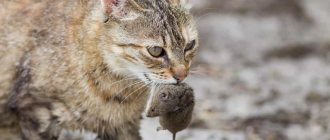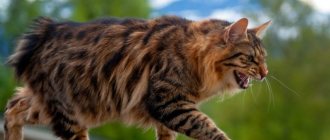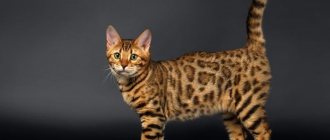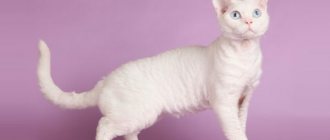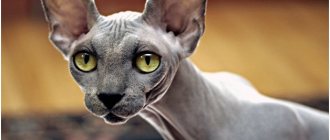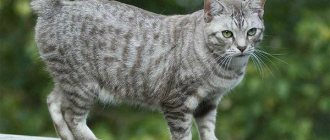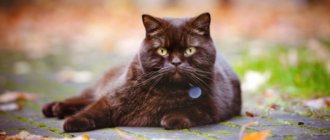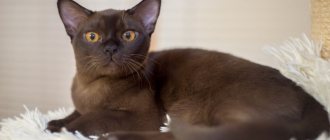In addition to their soft fur and purring, cats have always been famous for their ability to catch rats and mice. The rat catcher is not a breed, but a useful skill that representatives of certain breeds are predisposed to develop. As a rule, these animals do not become attached to their owner, tolerate loneliness well and have excellent health. How can you determine from a description of its appearance and character whether a kitten can catch rats or not?
History of Pied Pipers
The domestication of cats occurred in Egypt approximately 9 thousand years BC. e. In those days, the grain harvested from the fields was eaten by mice and rats. People saw how cats hunted them and began to lure and tame the nimble hunters. Since then, these animals have taken their place next to people, ridding them of rodents. For such merits, cats were called sacred animals, protecting food supplies and saving people from hunger. Since ancient times, cats have been given special honors, and high fines were imposed for killing them. The cost of a clever rat-catcher cat was equal to the cost of an ox.
Agile rat-catching cats in the old days were worth as much as an ox
There is a legend that says that during the global flood, rodents appeared on Noah’s Ark, dangerous to the inhabitants. Then cats were born from the lions, destroying all the rodents and saving the animals on the ship from them.
Cats conscientiously performed their duties in peasant homes, in monasteries, and at the royal court. Peter I ordered the adoption of cats to protect barns from the invasion of mice and rats. By order of Elizabeth, his daughter, 30 rat-catcher cats were brought to the Winter Palace from Kazan, the city where the most dexterous rat-catchers were believed to live. During the reign of Catherine II, cats appeared in the Hermitage to protect works of art from rodents.
During the siege of Leningrad, cats saved residents and the city itself 2 times. When, in the first years of the siege, all the animals were eaten due to hunger, many rodents appeared in the city, and the Winter Palace was simply swarming with them. To combat dangerous rodents, 5 thousand smoky cats were brought from Yaroslavl to Leningrad in April 1943, then a train of Siberian cats arrived, and soon rodents disappeared from the city.
Cats still regularly serve in the Hermitage, protecting the country’s cultural heritage from rodents and forming an integral part of museum life; they are its unique symbol. Museum employees say that throwing cats out into the street is like throwing a painting by an outstanding artist from the 10th floor.
Cats in the Hermitage protect the country's cultural heritage from rodents
The tailed guard of Leningrad: how cats saved the city from rats
Cat of besieged Leningrad
By 1943, all the cats in besieged Leningrad were eaten, which provoked an unprecedented proliferation of rats. Rodents moved in hordes around the city, entering homes, food warehouses, museums and other institutions. They tried to crush the rats with tanks, but this did not work, so since April 1943, hundreds of domestic cats were transported from Yaroslavl and Siberian cities to Leningrad, this was the only way to defeat the invasion of rats.
First of all, the animals were sent to food warehouses, then to museums, and the remaining pets were taken away by the townspeople. In total, more than 5 thousand cats were transported to the city. It is interesting that representatives of the cat family still serve in the Hermitage. In honor of the rat catchers, sculptures of the cat Elisha and the cat Vasilisa were installed on one of the houses on Malaya Sadovaya Street.
Monuments to the cat Elisha and the cat Vasilisa
Some nurseries today provide ratcatcher cats for rent. The advantages of such deratization are safety for humans and an affordable price compared to professional treatment of the premises. This method of rodent control is suitable for small buildings and dwellings. True, it is very difficult to find such an offer: owners are afraid to give their pets into the wrong hands, because it is unknown whether the rats on the customer’s territory are poisoned.
Rats are dangerous not only for grain supplies, but also directly for humans. Not every cat is capable of fighting them. There are special breeds of rat-catching cats. Their representatives have good health, strength and skills that allow them to hunt rats. What kind of breeds are these, and do such pets need special care?
The domestication of cats began in Ancient Egypt. People, seeing that these animals preyed on rodents eating food supplies, began to domesticate them. At that time, cats were sacred animals and they were fined for killing them. If a cat died in the house, people shaved their eyebrows as a sign of mourning. A good rat-catcher cat cost as much as an ox.
In Russia, cats performed the duty of catching rats from peasants, in the territories of monasteries and even in the royal palace. Sovereign Peter the Great ordered the adoption of cats to protect barns. By decree of Tsarina Elizabeth Petrovna, thirty rat catchers from Kazan were brought to the Winter Palace, since it was believed that the most skillful hunting cats lived there. During the reign of Empress Catherine the Great, cats were placed in the Hermitage to protect paintings and other valuables.
Ratcatcher cats help fight dangerous rodents
During the difficult years of the Great Patriotic War, cats saved Leningrad. When during the blockade all the animals in the city were eaten, houses and palaces were attacked by hordes of rodents. In 1943, 5 thousand cats arrived from Yaroslavl, and then another train of furry hunters from Siberia. Thanks to this, mice and rats quickly disappeared. To this day, fifty hunters, who are called “Hermitage cats,” live and work in the Hermitage in the status of Life Guards and museum employees.
The Siberian cat is an obstinate hunter
Nothing is known exactly about the origin of this breed; most likely, it was brought to Russia from Asia. She was nicknamed “Siberian” for her traditional long and fluffy fur. The cat, as you see in the photo, stands out for its strong build (females grow up to 5-7 kg, and males up to 9 kg) and powerful strong paws with excellent grip. In addition, the hind legs are slightly longer, which allows them to jump and run well.
The Siberian beauty has an obstinate character, excellent speed and reaction, which makes her an excellent hunter. Looking at her, you immediately understand that the cat has more than once participated in skirmishes with rodents. The animal is not very attached to humans, walks on its own and values freedom. By the way, to keep fit, your cat needs regular walks in the fresh air.
The only thing known about the origin of the breed is that it was brought from Asia to Russia. The breed got its name due to its fluffy and long coat. Some owners get these animals just for their attractive appearance. However, not everyone knows that this breed is a born rat catcher.
The appearance is characteristic: representatives of the breed have a strong body (the weight of males reaches 9 kg, and females - 7 kg) and strong legs with a strong grip. The hind legs of these animals are longer than the front ones, due to which they are able to develop greater speed in running and also jump well. Siberian cats have excellent reactions. Even from their glance it is clear that they are able to take part in the fight against mice and rats.
The character of these animals is quite obstinate. They do not become very attached to their owner, preferring to walk on their own. Their freedom is very important to these animals. Due to its free-spirited nature, such a cat needs periodic walks outside.
Cat or cat: who is the better hunter?
If we talk about the gender of mousecatchers, it still seems more reasonable to give the palm to the cat. In cats, the sexual instinct comes first, and if the animal is not castrated, the mustachioed cat can be distracted by “love” all year round, neglecting his hunting duties. We have all seen how skinny and tattered the tailed gentlemen return from their sexual adventures - it is obvious that they had no time for mice.
In cats, the estrus period is usually not long. And, raising kittens, as we said above, they hunt with double zeal and teach their offspring to do so. That is, they have double motivation. And female creatures usually have more persistence and diligence.
General features of rat catchers
The rat catcher is not a separate breed of cat, it is the valuable quality of the animal, the sharpness of its hunting instinct. According to felinologists (specialists in breeding cats), rat-catching cats can be identified by the following characteristics:
- muscular body, powerful jaws, strong legs;
- head shape - there is a relationship between the genes responsible for the instincts of hunters and the genes that determine the configuration of the skull of cats: rat-catching abilities are observed in animals with a triangular head (oriental type of cats);
- lush mustache and high ears with tassels at the ends: they allow animals to detect possible rustles, and this is very important for a successful hunt.
Ratcatcher cats usually have large ears that can detect the smallest noises.
Some rat hunters may be affectionate in nature, while others may be unsociable. There are animals that want to please their owner and often catch rats to show him their love. And there are cats that avoid people and do not welcome affection, but this is also quite normal.
By what signs can you recognize a rat catcher?
A mousetrap cat is not a breed, but a rare skill that a pet develops due to the conditions of its keeping and upbringing. The best hunters are considered to be mongrel cats, who have had to hunt mice for food since childhood.
Street animals are not spoiled by the attention and care of the owner, so the hunting instinct develops and remains for the maximum period
The following signs will help you recognize a future rat catcher in a kitten:
- if one of the parents is good at catching mice, by four months the skill will be transferred to the kitten;
- female. Cats catch mice better than cats, which is associated with increased activity and fearlessness. To feed her offspring, the mother cat will get food in any way, so her hunting instinct is heightened;
- head shape. Animals with a triangular oriental skull shape have greater potential for catching rats;
- activity in the game. If a kitten runs after ribbons, toy mice and catches them with his teeth, he will make a good hunter;
- physiological characteristics. The pet must be well built, have developed muscles, strong bones;
- high ears with tassels. Allow the pet to track rustles and squeaks, which increases the likelihood of finding a target;
- color feature. It is believed that the best hunters are tri-colored, tortoiseshell, and motley cats.
The listed signs increase the likelihood of a successful hunt. But the development of the skill depends on the conditions of detention and upbringing. If you keep your pet in an apartment and give it food when called, the hunting instinct will “die out.”
Maine Coon - the terror of all rats
The Maine Coon cat is a strong and agile breed that is resistant to various conditions, so it can live in areas with harsh climates. The cat is stately and large (the male grows up to 15 kg), has a predatory disposition and does not like affection from humans. Due to its size, it easily copes with rodents, so most often it is used by farmers whose farms are threatened by rats and mice. Maine Coons were originally developed as “working cats.”
The true king of the Maine Coon has a long and dense coat of predominantly dark shades (the photo shows the 3 most common colors), well-developed muscles, strong bones and a wide chest. A distinctive feature of the breed is its peculiar, erect, large ears with tassels. The tail is long and thick with flowing hair. All this makes the cat a threat to all rats and mice.
Breeds of rat-catching cats
There are certain breeds in the cat family, whose representatives are distinguished by excellent health, special dexterity and dexterity in catching rats.
Siberian cat
The cat was named Siberian due to its fluffy long hair. She is unpretentious, has a strong build, the weight of cats reaches 7 kg, cats weigh about 9 kg. She has strong paws and excellent grip. Due to the slightly longer hind legs compared to the front legs, the cat has the ability to run and jump quickly. Such animals are obstinate in nature, they have an excellent reaction, which is necessary when catching rats. They are independent and love freedom.
The Siberian cat has a strong build and excellent grip.
To maintain the desired shape, Siberian cats require regular walks in the fresh air.
Maine Coon
Cats of this breed are distinguished by mobility and strength. Maine Coons are hardy and able to live in regions with harsh climatic conditions. These large animals (males can weigh up to 15 kg) have the nature of a predator; they do not welcome human affection. Due to their size, they can easily deal with rats.
Maine Coons easily deal with rats
This breed of cat is distinguished by straight-set large ears, which have tassels at the ends. Maine Coons have long and thick fur. They have well-developed muscles, a wide chest, strong bones, and a thick and long tail. All this data allows Maine Coons to become a real threat to rodents.
Kurilian Bobtail
A feature of animals of this breed is a short tail, the length of which does not exceed 3–8 cm. But they have strong hind legs, which are longer than the forelimbs. And therefore the Kurilian bobtail runs well, jumps, and deftly strangles rats. Males of this breed weigh about 10 kg, females - 6 kg.
The Kurilian Bobtail is fearless and deftly strangles rats
Such cats are capable of completely destroying a mouse or rat hole. They are easy to train and can be trained. People keep them as companions; they get along easily with other animals. Bobtails have a fearless character.
European shorthair cat
Representatives of this breed destroyed rodents back in the days of Ancient Rome. European shorthair cats are called yard cats and are not considered purebred. However, they are popular in the world and are one of the best rat catchers. The predator's passion and agility help them successfully hunt rats and mice.
European shorthair cats are some of the best rat catchers.
Such cats are distinguished by individuality, independence, grace, and aristocratic appearance. They have a short coat, gray or silver marbled in color.
European cats get along well with people and are non-aggressive. They love to play, but do not completely obey their owner.
Cymric
Animals of this breed are similar to ordinary cats, but with a short tail. This structure, along with agility and tenacious claws, makes the Cymric a successful rat catcher.
Agility and tenacious claws make the Cymric a successful rat catcher.
It is good to keep these cats in private homes with open areas, as the animals require regular walks in the fresh air, freedom of movement, and physical activity.
British Shorthair
The hunting instinct and excellent natural inclinations make the British excellent rat catchers. Such cats are calm, friendly, and attractive in appearance. They love to please their owner by bringing him a caught rodent in their teeth in order to exchange it for rewards and something tasty.
Natural inclinations and hunting instinct make British Shorthairs excellent rodent catchers.
Females, weighing an average of 4 kg, try not to attack large rats, hunting only young ones or mice. Often this is enough to avoid a rodent infestation.
Russian blue
Russian blue cats are medium in size and light in weight, but this does not interfere with their hunting habits. Instant reaction and silent movement for a long time make these cats good rat catchers.
The Russian Blue cat has the ability to move silently and react instantly.
The ability of the Russian Blue to react to rodents is a true art: its speed of attack on the prey, accuracy and grace of movements are captivating. This is a thunderstorm of super rats, weighing about 500 g. The Russian Blue does not like partners of other cat breeds, but gets along well with rat catchers of its own breed. Opponent of tenderness from the owner.
What cats catch mice and rats
Many owners living in the private sector are specifically looking for mousecatchers. However, identifying them is not always easy. Some rely on genetics. In other words, if the mother was a mousetrap cat, then the kitten will inherit her gift. Another option is breed.
Mousecats are especially needed in private homes
There is no doubt that certain members of the cat family have a greater propensity for catching rats or mice. However, there are other ways to determine which cats are better at catching rats and mice.
How to identify a rat-catcher cat
The first thing you should pay attention to is the color of the animal. Representatives with gray, black, brown, or red skin blend better with nature and, as a result, are more successful hunters. White, unfortunately, in this case, is the most losing.
The second point is education. It is very important how the kitten behaved in childhood. Outdoor games with a bow, a ball, chasing the light of a laser pointer - all this is the preparation and development of hunting instincts.
For your information! Yard cats and female cats are excellent mousecatchers. The point is also that they develop their instincts from childhood. Hunting for them is a way to survive.
An equally interesting question is whether the rat-catcher cat will continue to hunt after castration. The animal's behavior changes after this operation, but this does not mean that it will lose its innate and developed instincts. The only thing you should be careful of in this situation is overfeeding your pet. Such measures often lead to obesity, and, as a result, hunting skills decrease. Therefore, a neutered cat should be given a special diet, so that he will continue to perform the task assigned to him.
By what external signs can one identify a future mousetrap?
It is believed that a cat that can successfully catch mice must look the part. What signs can be used to determine which kitten will be an excellent rodent exterminator?
Signs of a mousecatcher:
- long mustache;
- wild color - black, red or gray, two or three colors, with faint stripes and spots to blend with nature and remain invisible to its prey;
- short hair – long and thick guard hair when wet acquires an unpleasant odor, which can scare away the rodent;
- large ears and triangular head;
- large paws.
They tried to choose the best rat catcher using these signs several decades ago. In reality, there are no perfect rat hunters. Every cat has a hunting instinct from birth, but not all representatives of the feline family realize it with equal success.
Before you take a kitten into your home to catch mice, you should ask whether its mother was a good hunter. When raising their cubs, cats pass on their skills to them, including in catching rodents.
If the pet was taken from the street, it is highly likely that its hunting skills will be well developed. In purebred pets, the instinct is dulled, especially if several generations of animals have lived in apartments and do not even know what a mouse or rat looks like.
Is it possible to teach a cat to hunt if she doesn't show much desire to catch mice? In order for the animal’s natural instincts to awaken, it is necessary to let the pet feel a slight feeling of hunger. A cat should not be completely deprived of food - this is cruel and fraught with health problems. You just need to reduce the portion size: malnutrition will awaken the instinct in your pet. After the first successful hunt, it is advisable to reward the animal.
You need to teach your pet to hunt from childhood. There is no point in training an adult castrated cat. The purpose of its existence is food and sleep, such animals become lazy and quickly gain excess weight, and it becomes more and more difficult for them to run every year. But you can and should awaken a kitten’s interest in hunting. To do this, catch the mouse using a mousetrap and let your child play with it while it is still alive.
To activate the kitten's hunting instinct, you should play with it more often using a laser pointer or special toys. If your pet tirelessly chases them, he will become a professional in catching mice.
Features of care and maintenance
A real rat catcher can be raised from a small kitten. You just need to use some tips:
- To maintain the hunting instinct, the animal should be given food in small portions at least 5-6 times a day. To prevent the cat from becoming lazy, it should not be overfed. Food should not be in the bowl all the time, but the cat should not be left hungry either, since the rat hunter will need strength to attack the rodents.
- It is necessary to cultivate a hunting sense in the future rat catcher, praise and encourage him for any prey he catches: a bird, a mouse, a fly.
- It is difficult for a person to raise a kitten to be a rodent hunter, and therefore there is no need to separate it from its mother cat for up to 5 months so that during this time she can teach him the necessary skills.
- The pet must lead an active lifestyle; it requires not only toys in the form of balls, mice, bows, but also special play complexes.
The gaming complex will help your pet maintain an active lifestyle
- Rat catchers need to be vaccinated against rabies to boost their immunity, since rats are aggressive animals. When cats receive wounds from rodents, the damaged areas must be carefully treated and consulted with a veterinarian.
Otherwise, the care and maintenance of rat catchers is no different from the care of ordinary cats.
general characteristics
Experts involved in breeding cats have identified several main signs that can help you understand how strongly a pet’s hunting instincts are developed.
Here they are:
- Sexual characteristic. As practice shows, females hunt better. Males do not need to provide food for themselves and their offspring; their hunting instincts are less developed.
- Head shape. The gene that determines the presence/absence of the hunting instinct is closely related to the genes responsible for the shape of the animal’s skull. Ratcatchers typically have a triangle-shaped head.
- The ears are high, with tassels at the ends, and a bushy mustache. If a pet has this, then it is able to track the slightest changes in the air and rustles. The skills will come in handy during the hunt.
- Bright coat color. Monochromatic animals are quite easy to spot, but tricolor animals, as if dressed in camouflage, are not noticeable to the “enemy”.
How to choose the right cat
Oddly enough, non-pedigreed animals that have lived on the street for some time are best suited for the role of a rat trap. The experience they gain brings invaluable benefits in hunting rodents. Such cats know how to get their own food, have the proper “fighting” skills and hardening. Catching rats is one of the basic components in their survival. This refers to animals that were born and raised on the street, and not those that ended up there after a long life in the house.
If you do not want to adopt a cat from the street, then it is worth remembering that a “rat trap” is not a specific breed. If desired, almost any cat can be raised to become a rodent hunter. Still, there are cat breeds that cope with this role better than others. These include:
- Maine Coon;
- Siberian cat;
- Cymric;
- Kurilian Bobtail;
- Siamese cat;
- European;
- Siberian;
- Russian Blue;
- British Shorthair.
Time has shown that these are the breeds that hunt pests most effectively. When choosing the right cat, you should also pay attention to a number of the following factors.
The animal's build must be large. When hunting, a cat will need developed muscles and physical strength. Low stature is another important point. It will allow the rat trap to be more compact and agile.
Another sign of an excellent rodent hunter is the triangular structure of the skull. To more accurately determine the shape of the skull, simply press the animal’s ears to its head. When choosing a rat-catcher cat, it is better to give preference to the triangular structure of the skull.
It has been proven that the hunting skills of females are superior to those of cats. This is due to the cat’s lifestyle: she needs to protect her offspring, feed them and teach them how to get food. This is why you should choose a cat if you want to achieve maximum efficiency.
If you are going to raise a ratcatcher from a kitten, pay attention to how she plays with a toy mouse. Real hunters try to use their teeth and gnaw their prey rather than roll it with their paws.
Questions about breeds and external characteristics.
As has already been noted, the best mousecatchers are cats raised in appropriate conditions.
Although some experts insist that there are still breeds of mousecatchers. These are all European cats with short hair. In this category, the following are distinguished by color:
- European tabby. Outwardly, it resembles a small tiger. Cats of this breed are very strong and stocky. They don't just catch mice, they ruthlessly destroy them.
- European speckled. These are good mouse hunters of various parameters. They also catch lizards, snakes, small birds and fish.
shutterstock
Ratcatcher cats for rent: where to find, cost
Buying a real rat catcher is quite difficult: you can be deceived for a lot of money. However, in some cities it is possible to rent a cat. You should know that ratcatcher cats are available for rent from breeders, many specialized nurseries, and animal and pet supply stores. After the rats are killed, the animal is returned.
For a cat, being in a new place with unfamiliar people can be stressful, so you cannot be sure that in such an environment he will catch rodents.
You can rent a ratcatcher cat
For this purpose, you can find a rat-catcher cat via the Internet, using message boards, for example, the site for finding part-time jobs YouDo, or specialized forums. There is no fixed price for such services; sometimes it is set depending on the cost of the cat itself. Typically, the price of such a service varies from 500 to 3 thousand rubles.
Forum participants generally have a negative attitude towards giving their animal to catch rats, since no one wants to create a stressful environment for the cat, and besides, this can be dangerous: the rats may already be poisoned.
Kuril defender
The famous Kurilian Bobtails, despite their rather cute appearance, are excellent rat-catching cats. They are aggressive towards attackers, capable of repelling even the invasion of dogs into the territory they protect, and they deal mercilessly with rodents. Bobtails also love plenty of space to play around. In addition, they are well trained and are not at all afraid of water.
The breeds of cats that are good rat catchers also include the Kurilian Bobtail. The bobtail cat first appeared in Russia in the 20th century, when it was brought from the Kuril Islands. These animals are distinguished by their loyal nature to humans. In some ways they even resemble dogs in character.
Kurilian bobtail kittens immediately become attached to a person and try in every possible way to protect him from all sorts of troubles. The latter include rodents. By the way, in addition to mice and rats, bobtails are capable of driving away small dogs that have encroached on their territory.
The breed is distinguished by a small tail, the maximum size of which is only 8 cm. In body structure, these animals resemble a lynx: they have long and powerful hind limbs, allowing them to make excellent jumps. Kurilian bobtails are capable of running at high speed and crushing mice and rats.
The weight of these animals is up to 6 kg in females and up to 10 kg in males. Whatever the hole is - a mouse or a rat, the Kurilian Bobtail can cope with it; it is not without reason that they are often found on farms and in houses where rodent pests predominate.
There have also been cases of cats predicting earthquakes and gas leaks. The Kurilian Bobtail has the character of a warrior: bold and daring.
The peculiarity of the breed is its short tail, which grows only 3-8 cm in length. In return, the animal has limbs of a special structure: the hind legs are always more powerful and longer than the front ones, thanks to which the “domestic lynx” jumps well, runs quickly and crushes rats with ease. The color of a cat can be very different, with the exception of white, lilac and chocolate shades. Weight reaches 10 kg in males and 6 kg in females. The expert will tell you more about the breed in the next video.
We invite you to familiarize yourself with: Mating of British breed cats: how long they go during pregnancy, childbirth || Rules for breeding cats of the British breed
Bobtails can destroy entire mouse and rat holes, so they are most often kept outside the city, on farms and in other places where there are problems with rodents. These cats are trainable and amenable to training, so they do not cause problems for their owners. Companion cats easily find language with both humans and other pets.
Cat and mouse - a game without giveaways
Catching a rat that is more intelligent than a cat is not easy. In this duel between a predator and a rodent, the winner is unknown. There have been cases when a rat managed to get the better of a cat. Therefore, not all murkas dare to play the deadly game of cat and mouse.
If you notice rat bites on your pet's body, disinfect them immediately. It won't hurt to contact a veterinarian. Timely vaccination will help minimize the risk of infection (the main risk is rabies).
People have long valued cats that can catch and strangle rodents. There is no creature more harmful than a rat, which:
- spreads diseases (the plague epidemic, which claimed 60 million lives in the 14th century, was its work);
- recognizes and adapts to poisons (if an individual survives as a result of deratization, it will avoid the type of pesticide used, and its offspring will become immune to it);
- chews everything in its path, even metal and concrete;
- in a year he can eat 12 kilograms of food and spoil even more.
But the ubiquitous and omnivorous creature has a formidable opponent - the rat-catcher cat. Statisticians have calculated that if it were not for the help of a domesticated predator in the farm, it would feed mainly toothy pests, not people.
Abyssinian cat
Abyssinian cats are the oldest representatives of the domestic cat family. They were depicted in ancient Egypt on frescoes and even made into statues. For a long time, scientists argued that Abyssinian cats formed in Abyssinia (Ethiopia). However, recent research has shown that the breed may have come from Southeast Asia.
Abyssinian cats have a very capricious character. They are curious and demanding, so they are ready to explore every corner where they live. “Abyssinians” will not let anyone near them if they are dissatisfied with something. However, they appreciate affection and love to talk.
Thanks to its large ears, the breed is considered one of the best rat catchers. “Abyssinians” are very energetic and are always ready to spend their reserves of strength. They often direct their activity towards hunting.
Some selection tips
To help those who want to purchase or raise a pet hunter, here are some recommendations:
- A rat is a large rodent. Accordingly, the cat must have a developed skeleton, muscles, and strong jaws. A lazy animal will not be able to hunt. A cat's body size is based on muscles, not layers of fat.
- When choosing a breed, you need to consider natural (aboriginal) varieties. Artificial selection greatly reduces skills. Those cats that owe their origin to wild ancestors are more ready for hunting. Many consider barn cats to be champions in catching rodents. The strongest individuals survive in the natural struggle for existence.
- Any cat on the street does not have to be a rat catcher. Many of them are former pets, who, by chance or by their owners, live in basements and entrances.
- One way to find a skilled hunter is to take an older kitten from a mother rat catcher. The cat teaches children, they are given abilities coupled with natural instinct. There is no need to adopt kittens when they are small. It takes time to learn and mature.
Important ! If a rat bites you, you need to help your cat. The veterinarian will treat the bite site and give an injection. It is easier to prevent the problem and get your pet vaccinated on time.
How to raise and care for hunters
Even if a kitten of the right breed has been chosen, this does not guarantee that it will become a rat catcher. The determining factor here is the behavior of his mother cat. If she hunts rodents, then the kitten will acquire the necessary skills from a very early age, and this is difficult to instill artificially.
You cannot separate a kitten from its mother too early, because only she can teach the baby to hunt. It is better to take an already strong fluffy at the age of 4-5 months. Author's advice
When raising a future rat catcher, you need to adhere to the following rules:
- They will encourage the pet's love of hunting and praise it for catching a rodent.
- Don't starve your cat by trying to encourage him to hunt. A hungry animal will either run away or eat from neighbors or in a garbage dump.
- Monitor the physical shape and body weight of the purr, do not overfeed. It is recommended to feed 5-6 times a day, but in small portions.
- Get the required vaccinations, especially against rabies. This is important because during a fight with a rat, the rodent may bite the cat.
If your cat is scratched or bitten during the accident, you should contact a veterinarian to avoid developing rabies.
The animal must be vaccinated against rabies
Catchers of rodents among cat breeds
Rat catchers are not listed in the breed registries of felinological organizations. Everyday experience shows that most often rat-catching cats are found among the following breeds:
- the Kurilian Bobtail is a brave hunter, capable of repelling attacks not only from rats, but also from dogs, an excellent swimmer, and easy to train;
- Russian Blue - a favorite of sailors, a thunderstorm of “super rats” reaching 500 grams, an opponent to bask on the owner’s lap; obstinate towards “stranger partners” (but gets along well with rat-catching cats of her own breed);
- Siberian - an unpretentious and silent virtuoso hunter, distinguished by sharp bladed teeth and huge heavy paws;
- Kimrskaya - a frisky short-tailed beauty, distinguished by a heightened hunting instinct, amazing dexterity, speed of reactions, excellent health;
- the European Shorthair is a faithful defender of barns, ready to pursue prey even in a state of satiety;
- The Maine Coon is the largest rodent catcher, combining strength, agility and beauty.
Read:
Transporting cats in Russia: in a car, train, plane, what you need to prepare
The photos will help you evaluate the “fighting qualities” of rat-catching cats of the named breeds. Furry hunters differ in character and attitude towards their owners - they can be affectionate or unsociable. What unites them is their breeding under natural conditions, and not through artificial selection.
Maine Coon
The history of the breed is shrouded in legends and mysteries. It is generally accepted that the first Maine Coons originated in Maine (USA), where aboriginal cats adapted to the climate of the area. Distant relatives of the breed were taken on ships, where the cats caught rodents and saved provisions. Maine Coons escaped extinction only because they had excellent hunting skills. Many farmers gave their preference to them.
American Maine Coons are considered the largest cat breed in the world. They are perfect for the role of a rat-catcher cat. Despite the fact that since the mid-twentieth century they began to be used as companions, the breed still retains its active hunting instinct. Now Maine Coons are the most popular breed in the world.
Russian blue cat
The blue cat is a prominent representative of rat-catching cats. This animal does not watch its prey for hours; it, immediately noticing a moving object, rushes after it. Representatives of the blue cat breed have an aristocratic character, they are very affectionate, kind, capable of becoming attached to their owner and following on his heels.
The blue cat is very friendly and loves meeting new people, but at first she is suspicious and wary of new people. She gets along well in the same territory with other animals and gets along well with small children. Representatives of the breed are interested in all new objects that appear in the house or apartment.
It will not be possible to forcefully pet a cat, since it does not like this; the animal itself will come to a person when it needs affection. Raising blue cats at the highest level. They are incapable of unpleasant surprises, for example, gnawing flowers, damaging furniture and wallpaper. Pets have a good memory, so if you explain to him once what he can and cannot do, he will remember it and will not make the owner nervous.
The blue cat is the perfect animal. But there is one drawback of this breed; it is intolerance to swearing and scandals. If conflict situations often arise in the family where a cat lives, the animal becomes a lethargic, apathetic creature.
Caring for a blue cat is simple and easy; all you need to do is bathe it once every six months and brush it several times a week. Ear cleaning should be done regularly. To do this, you can use cotton swabs or a soft cloth soaked in a special ear cleaning liquid intended for cats. There must be a scratching post in a house or apartment, since animals sharpen their claws themselves and do not need to be trimmed.
It is necessary to feed your pet both industrial feed and natural food. It is recommended to include beef or chicken, yogurt, sour cream, kefir, and cottage cheese in the animal’s daily diet. You should not feed your cat fish and milk, as such food has a bad effect on the pet’s health. The animal needs to periodically add vitamins to its food to strengthen its coat.
Blue cats are practically not susceptible to various diseases. If you take proper care of your animal, your pet will be in good health.
The Russian Blue cat has long established itself as an excellent mousetrap. Families of several generations adopt a Russian Blue cat with confidence and without any doubts. Elegant, beautiful, clean, and even knowledgeable about real hunting. Such a cat will protect your hearth from small and not so small rodents for many, many years.
ATTENTION, TEST! Answer a few simple questions and find out what kind of owner you are for your cat:
Does your cat have a name?
How often do you play with your pet?
Do you get your vaccinations and parasite treatment up to date?
Is your kitten spayed/neutered?
What do you feed your purr?
What kind of owner are you for your cat?
Your kitty is very happy
Congratulations! Your purr is healthy and happy, surrounded by care and love. You are a responsible and good owner for your kitty.
Your pussy could be happier
Hmm... with such an owner, even the cockroaches will all die. Maybe you should have gotten a cactus instead of a cat? Yes, you are not the best and most caring owner, but you still have a chance to fix everything. Start taking proper care of your pet.
Please note that sterilization affects the behavior of the pet. It affects cats and kittens differently. Males may become fatter and lazier, while females, on the contrary, will hunt for mice more actively.

